






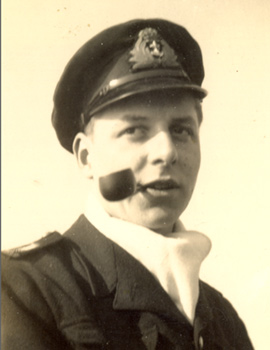 After survivors
leave Sub Lt Miroslav Lansky RNVR was posted to HMS Venomous at Rosyth on the 20 February 1945 in response to a puzzling but urgent request for an officer who could speak Russian. Venomous was an elderly V & W Class destroyer built in 1919, twenty five years before HMS Cassandra.
Stripped of most of its armament and with one of its two boilers (and
funnels) removed she had spent a dull six months in the Irish sea
towing targets for Barracuda aircraft based in the Isle of Man to attack with unarmed torpedoes before nearly being lost with all hands in a hurricane on the East coast of Scotland.
After survivors
leave Sub Lt Miroslav Lansky RNVR was posted to HMS Venomous at Rosyth on the 20 February 1945 in response to a puzzling but urgent request for an officer who could speak Russian. Venomous was an elderly V & W Class destroyer built in 1919, twenty five years before HMS Cassandra.
Stripped of most of its armament and with one of its two boilers (and
funnels) removed she had spent a dull six months in the Irish sea
towing targets for Barracuda aircraft based in the Isle of Man to attack with unarmed torpedoes before nearly being lost with all hands in a hurricane on the East coast of Scotland.
Lt Cdr Arthur Guyon Prideaux RNVR had replaced Lt Cdr Derek Lawson RNVR, both lawyers in civilian life, as the commanding officer of HMS Venomous on the 6 February 1945 and Miroslav joined his new ship on the 20 February, replacing Sub Lt Wilfred Beckerman RNVR whose alertness helped save Venomous from disaster during the east coat hurricane. There was also a new "No. 1", "Jimmy" Blair who replaced Greenaway and was surprised to find himself at thirty-one the youngest officer in the wardroom.
Miroslav
had joined an elderly V&W Class destroyer
destined for the breaker's yard but she had one more mission to
perform. Germany formally surrendered on the 8 May 1945 but the German
Naval Commander in Norway would only surrender to the Royal Navy. The
decision was taken to send destroyers from the Rosyth Escort Force to
accept the surrender of German naval forces in four coastal towns:
Stavanger, Bergen, Trondheim and Kristiansand South.
There was a lot of competition amongst the commanding officers to be
selected by Captain Ruck Keene, Captain (D) of the Rosyth Escort Force,
for this last wartime mission, Operation Apostle. Lord Teynham, appointed as Naval Officer in Command (NOIC) at Kristiansand, briefly commanded HMS Venomous in 1942 and may have used his influence to see Venomous was selected along with HMS Valorous to go to Kristiansand South on an inlet off the Skagerak the strait between Norway and Denmark.
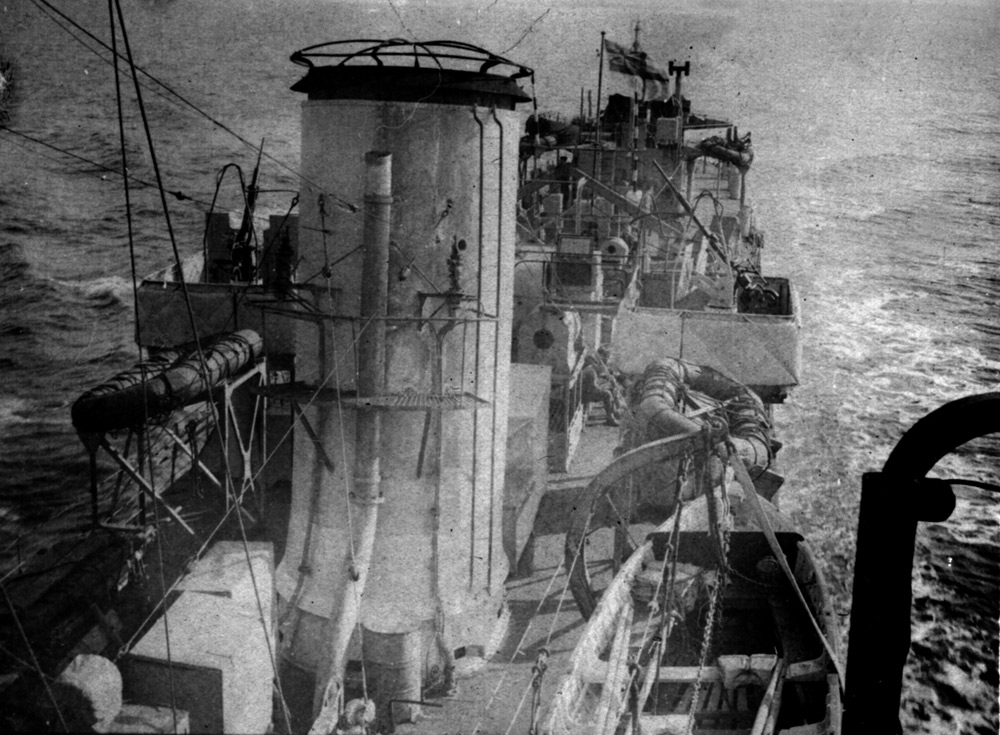
Lt Cdr Prideaux was born
in Colombo, Ceylon, and returned to Britain with his mother and two
unmarried sisters in 1939 and joined the Royal Navy. His 300 page memoir of his wartime service in the Royal Navy Museum
contains the most detailed description we have of this "final chapter"
in the life of this elderly V & W Class destroyer.
Derek Lawson was a keen photographer who owned a Leica and his family album contains photographs of the officers under his command.Most remained with Venomous when Prideaux took over as CO. They were all RNVR with the exception of my father, Lt(E) William R. Forster RNR, a Chief Engineer in the Merchant Marine, who described the ship's engines as "shot" and needed all his twenty years experience as a marine engineer to keep them running. There were three lawyers in the Wardroom, Prideaux himself, Derek Caudle and Martin. Thorp was a bank manager in Lancashire.
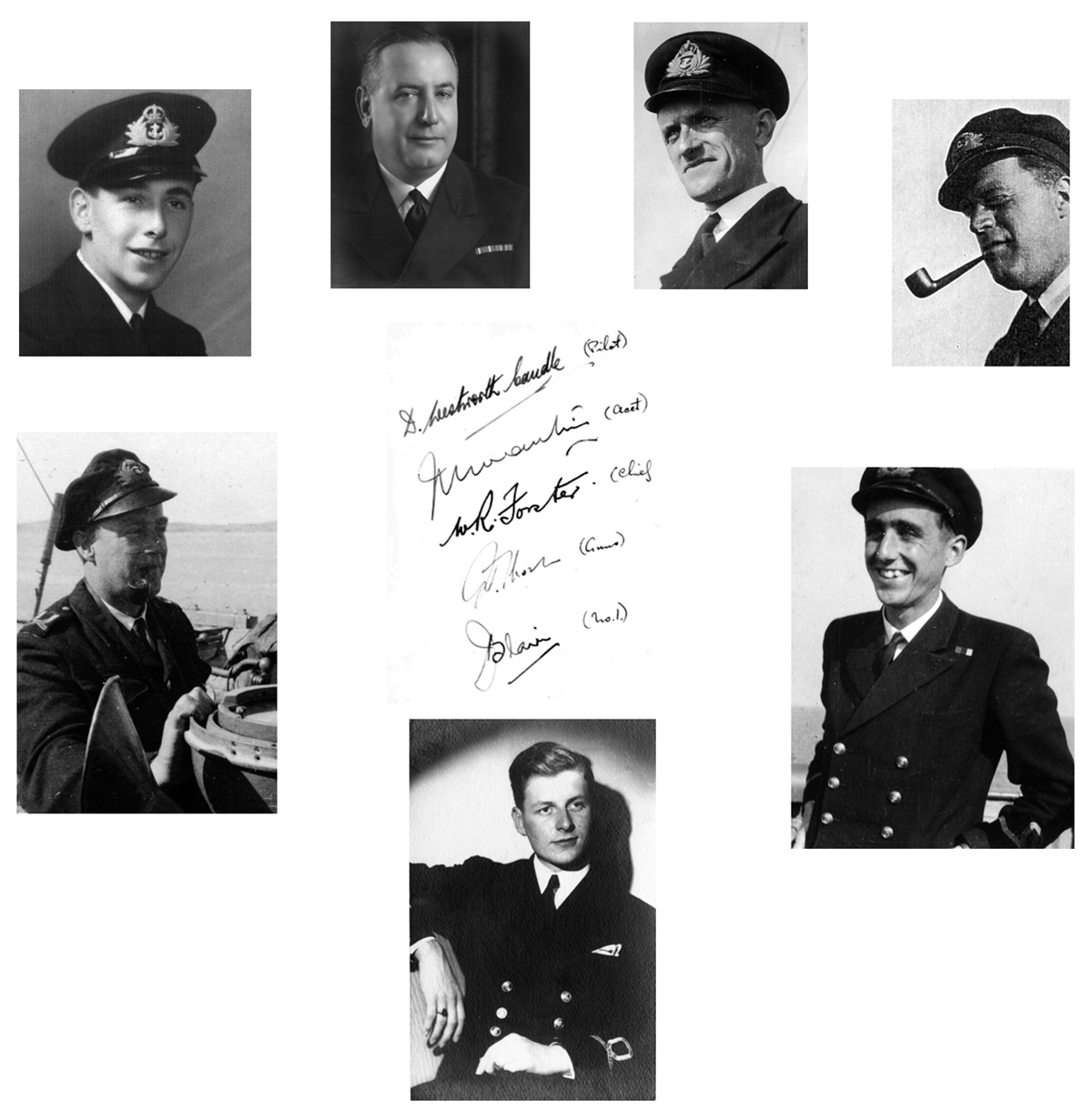
The officers on HMS Venomous at Kristiansand
From top left: Jimmy Blair (No 1), W.R. Forster (Chief), Martin,
Prideaux (CO), Thorp (Guns), Caudle (Pilot), Mirolslav Lansky (centre)
| Lt Cdr A.G. Prideaux RNVR - Commanding Officer | Sub Lt Thorp, RNVR - Gunnery Officer |
| Lt "Jimmy" Blair RNVR - First Lieutenant |
Sub Lt Martin RNVR |
| Lt Derek Caudle RNVR - Navigating Officer | Sub Lt Miroslav S. Lansky RNVR |
| Lt (E) W.R. Forster RNR - Engineer Officer | |
Venomous loaded
supplies into the space freed by the removal of one of its two
boilers, took onboard a number of non naval personnel including
Marines, Army and Leading Aircraftsmen (RAF), embarked German pilots to
conduct them through the coastal
minefield and left Rosyth in company with Valorous and accompanying minesweepers on the 12 May.
The two destroyers reached Kristiansand's large natural harbour on the
afternoon of the 14 May and were greeted rapturously by boatloads of
Norwegians who clambered aboard. In later years a young Norwegian recalled the atmosphere:
"To
anyone who was not there it is impossible to understand what the sight
of these ships meant to the Norwegian people of the town, and for me it
is impossible to describe the enthusiasm that greeted the ships and
ships' companies - it was all joy."
The events of that day made a big impression on the officers and crew of Venomous: children tasting chocolate for
the fist time and more mature visitors emptying the wardroom's
supply of Scotch, young Norwegian women making a sailor blush when
directed by his shipmates to where he was bathing, the handsome lady
leading the official welcoming delegation who embraced Lt Cdr Prideaux
RNVR to the delight of his men made a fitting end to
five long weary years of war.
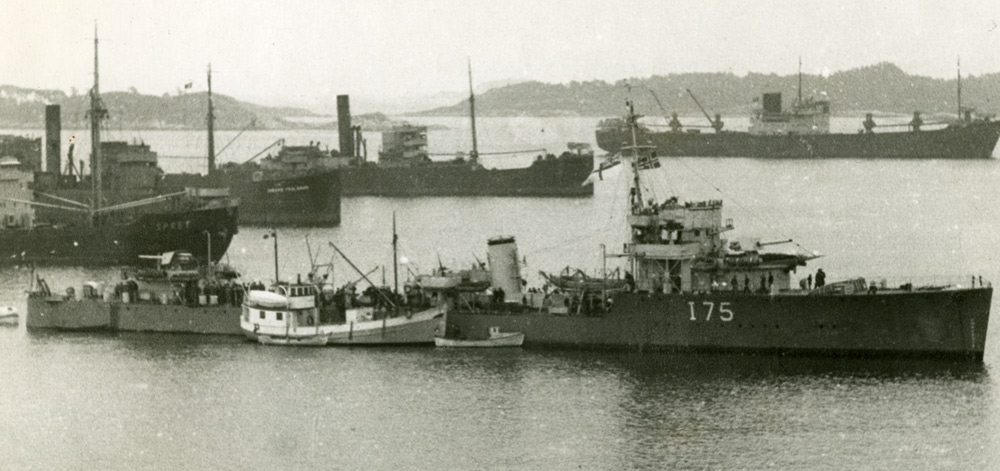
The first surrender ceremony was held aboard HMS Valorous
on the day the destroyers arrived and the following day AB Fred Mercer
was sent in the ship's whaler to bring the Admiral from the Marvika
U-Boat base to HMS Venomous
for a second ceremony. It was the proudest moment of Fred's life when the Admiral congratulated him on his seamanship. Several officers
acquired Mauser's, the standard handgun of officers in the Kriegsmarine.
Sub Lt Miroslav Lansky RNVR taking a stroll through the small town of
timber buildings met a "terribly shy figure", a "decent looking
soldier"
with the rest of his platoon hanging back behind, who handed
over his two hand guns as a symbolic act of surrender. Miroslav
still has them today. His German came in useful but the Russian he picked up while stranded in Murmansk after HMS Cassandra was
torpedoed was not required. There were thousands of starving Russian POWs in
camps at Kristiansand and one was smuggled
aboard by a rating and fed with food from the ship's Galley but Miroslav was not asked to act as an interpreter.
HMS Venomous was ordered back to Rosyth after two days but her sister ship, HMS Valorous,
with Lord Teynham aboard and commanded by Lt Cdr J.A.J. Dennis RNVR
remained at Kristiansand for three weeks. Fred Mercer also stayed
behind and returned on one of the German U-Boats with a Royal Navy
crew. Venomous left on the 17
May, Norway's National Day, as the bands were striking up for the
parades in which the officers and men of HMS Valorous marched with the SAS unit commanded by Brigadier "Mad" Mike Calvert. Some months later the officers and crew of Venomous
and the other Royal Navy ships sent to Norway were presented with a
handsome scroll signed by King Olaf thanking them "for restoring
Freedom to our Land".
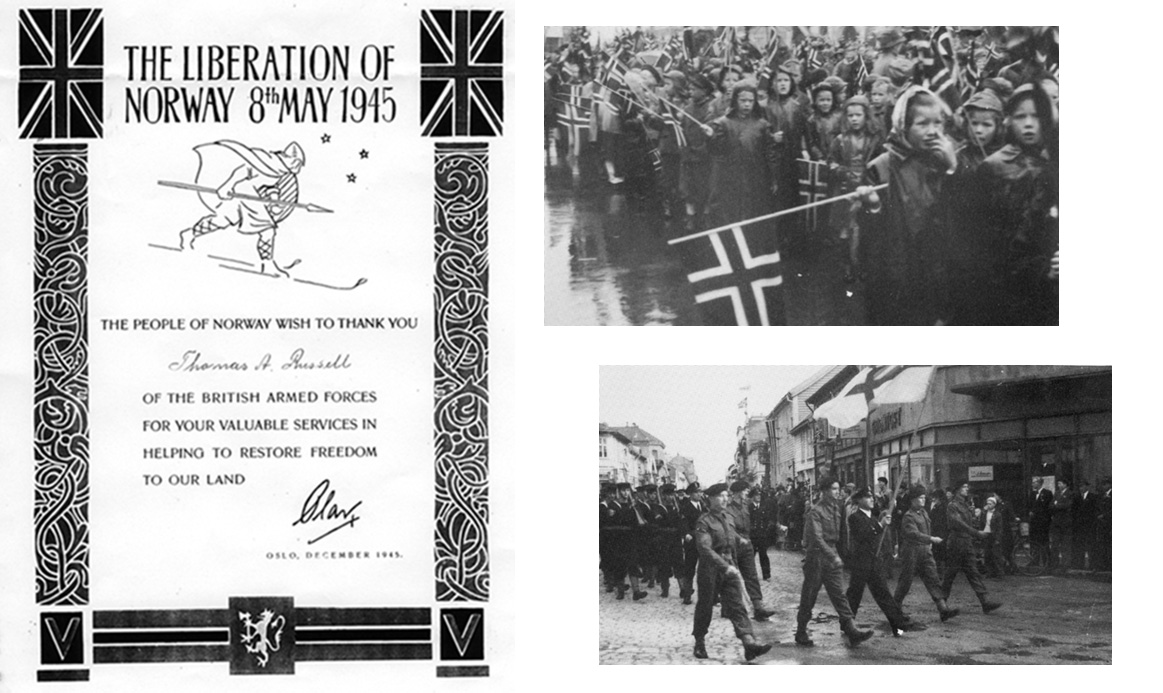
Soon after Venomous returned
to Rosyth she was towed up river to Grangemouth, flooded and
left in the shallows no more than a hulk with Lt(E) William R Forster
RNR as the sole officer aboard. The breakers yards were busy and it was
November 1948 before she was scrapped at Charlestown. Her name is kept
alive by the Sea Cadet unit at Loughborough, TS Venomous.
The officers and crew of HMS Venomous transferred to HMS Havelock which took over from Venomous towing
targets for Barracuda aircraft to attack with practice torpedoes. The
war in Europe was over and attention shifted to the war in the Pacific
against Japan. The ability of the young Sub Lieutenant with the foreign
sounding name to master obscure languages had been recognised and in
July the Admiralty sent him to the US Navy’s Japanese language school
at the University of Colorado. At its peak there were 600 students and
125 teachers, mostly women born in the US of Japanese parents. For most
students this was the most intense period of study of their lives. The
murderous schedule focussed on reading, conversation and dictation -
including Japanese calligraphy - and they faced a three hour exam at the end of every week. The
atom bomb and the surrender of Japan brought an end to his studies at
the University of Colorado and he returned to Britain, a drab country
after America, and was discharged from the Royal Navy in March 1946.
On
returning to Britain and being discharged from the Navy he resumed his
studies at Oxford and as a former serviceman was allowed the
flexibility to complete his degree in two years.
His tutor, John S Fulton (1902-86), later Lord Fulton of Fulmer, became
a prominent public figure. Britain seemed dreary and sad after America and
faced years of rationing and austerity. He
enrolled for a post graduate course in international affairs at the University of Virginia - and persuaded his parents to
join him in the States. They had never applied for British nationality
and were still registered as aliens. They had left Czechoslovakia in
1920 within two years of it being created by the Allies at the end of
the Great War and had seen it swallowed up by Nazi Germany and then by
Stalin's Soviet Union. Although they retained their Czech passports Olga's
would expire in March 1948.
His father had five brothers, all living in the States. Emmanuel and Vlasta Lansky had emigrated in 1923 and lived in Cicero (best known as the town where Al Capone and Frank Costello operated in the prewar Prohibition era) near Chicago with their three children and were willing to sponsor Joseph and Olga's application for US Citizenship. Miroslav traveled in style to New York on the Queen Elizabeth on the 16 September 1947 not long after graduating and his parents, Joseph and Olga Lansky, flew to New York two days later. Miroslav lived with overseas students at the University of Virginia's International House on the Campus at Charlotteville.

Miroslav continued to study Russian, a potentially useful language during the
Cold War. He had hoped that studying international relations would help
him secure a job at the UN, but found that little importance was given
to that subject. In order to earn a living he took a job for a time
with the Arthur Murray School of Dancing in
New York. He loved classical music and the opera and frequently went to
the Metropolitan Opera House. He was also very interested in the stock
market.
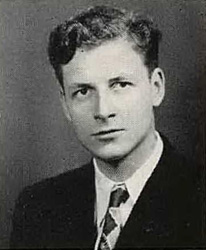 His parents, Joseph and Olga, bought a large house in fashionable Long Beach in New York state. His
Mother took a close interest in his social life and wrote to him offering advice on his
choice of girl friends. He was a good looking self assured young man
who did not take life too seriously and must have found it unsettling
to be questioned about the girls he took out. He had a Chinese girl friend, Ihming (Ming), whom Olga strongly disapproved of, but with whom he remained good friends.
He tried to learn the
Chinese characters through a system of cards which he carried around
everywhere but he never became completely fluent in Chinese. Then,
as his daughter Tamara explained, "he put his name down for the
UN Translators' exam which he took in French and Russian and
got first place and he joined the
United Nations as a translator in 1955. Olga was
overjoyed - finally her son had succeeded in joining the UN. Now she
was going to make sure he married the right woman!"
His parents, Joseph and Olga, bought a large house in fashionable Long Beach in New York state. His
Mother took a close interest in his social life and wrote to him offering advice on his
choice of girl friends. He was a good looking self assured young man
who did not take life too seriously and must have found it unsettling
to be questioned about the girls he took out. He had a Chinese girl friend, Ihming (Ming), whom Olga strongly disapproved of, but with whom he remained good friends.
He tried to learn the
Chinese characters through a system of cards which he carried around
everywhere but he never became completely fluent in Chinese. Then,
as his daughter Tamara explained, "he put his name down for the
UN Translators' exam which he took in French and Russian and
got first place and he joined the
United Nations as a translator in 1955. Olga was
overjoyed - finally her son had succeeded in joining the UN. Now she
was going to make sure he married the right woman!"
In
1957 he was sent with a team from UN New York to cover a regional
meeting of the Economic Commission for Latin America at La Paz,
Bolivia, and met a young English woman from Bolton, Evelyn
Neary, whose parents had moved to Lima to manage a cotton mill during
the Depression. She described their first encounter when "this
gorgeous man"
was dictating his translations to her. He
was thirty two, ten years older than her. They eloped and got married
within two weeks without notifying his parents and Olga was presented
with a fait acompli.
In
1958 he was transferred to the UN Economic Commission for Asia and the Far East in Bangkok, Thailand, where two of
their three children were born. The contrast could not have been more extreme. "There
were only a handful of hotels and the one we stayed at when we first
arrived - the Rattanakosind - was near the main Bangkok market and one
of the more important temples, the Reclining Buddha. The bathroom
consisted of a huge earthenware 'ong' full of water with a scoop to
slosh water over oneself - very satisfying in that heat. The toilet, a
hole in the floor, seethed with mosquitoes. There were bedbugs - my
only ever encounter with those creatures" (Evelyn Lansky).
"He spent his spare time and money chasing insects, putting them to sleep in chloroform and then pinning them in boxes. We have one of the most amazing collection of what must now be extinct species of butterflies, beetles and spiders!" (Tamara Lansky). "We had a series of exotic pets - particularly a couple of gibbons - and he made a vast number of 16 mm movies of everything. Mark was born in December 1959 and learned Thai words and little songs from the Thai nursemaid and the cook, and the Latin names of insects and butterflies from his father before he was two. Tamara was born in 1961 just before we left for Geneva" (Evelyn Lansky).
They returned to Europe when he joined the United Nations Office in Geneva (UNOG) just after Tamara was born in 1961 and their second daughter, Alexandra, was born soon afterwards. The children grew up in a renovated farm house at Fillinges about sixty miles south west from Geneva. He took a great interest in both cooking and gardening but his taste in food was not always shared by the family: "He cooked such weird things: tripe, and kidneys, and stuff like that. The worst was brain. He loved the taste and texture of brain, we did not like it one bit! Can you imagine as a nine year old being served brain? He spent most of his free time gardening and walked at least twice a day, every morning and afternoon, in the woods, fields, wherever he could. He loved to go mushrooming, and that is a skill he did transfer to my brother and myself" (Tamara Lansky).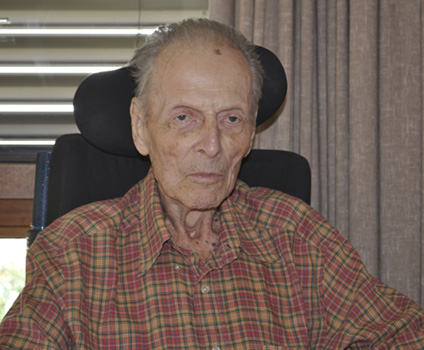
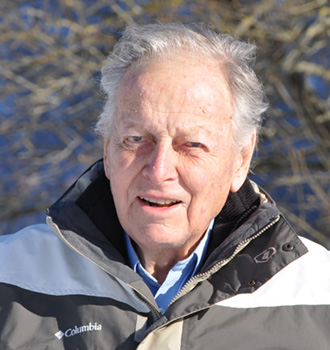
Miroslav Stanley Lansky was the last officer alive who served on HMS Cassandra when she was torpedoed on the 11 December 1944 and on HMS Venomous
when sher accepted the surrender of
German naval forces at Kristiansand in Norway on the 15 May 1945. He was in poor health when I contacted the family and I
relied on his wife, Evelyn Lansky, and daughter Tamara, to help me tell
his story.
It did not seem appropriate to give a detailed description of events at Kristiansand since this can be read in A Hard Fought Ship: the story of HMS Venomous
but details received since publication
including Miroslav's own memories are given here and it is hoped that
this will lead to further contacts with crew members of HMS Venomous. Lt
Cdr Arthur Guyon Prideaux's unpublished memoir of his wartime
service in the Royal Navy can be seen in the Library of the Royal Navy
Museum in Portsmouth (Ref 1997.55).